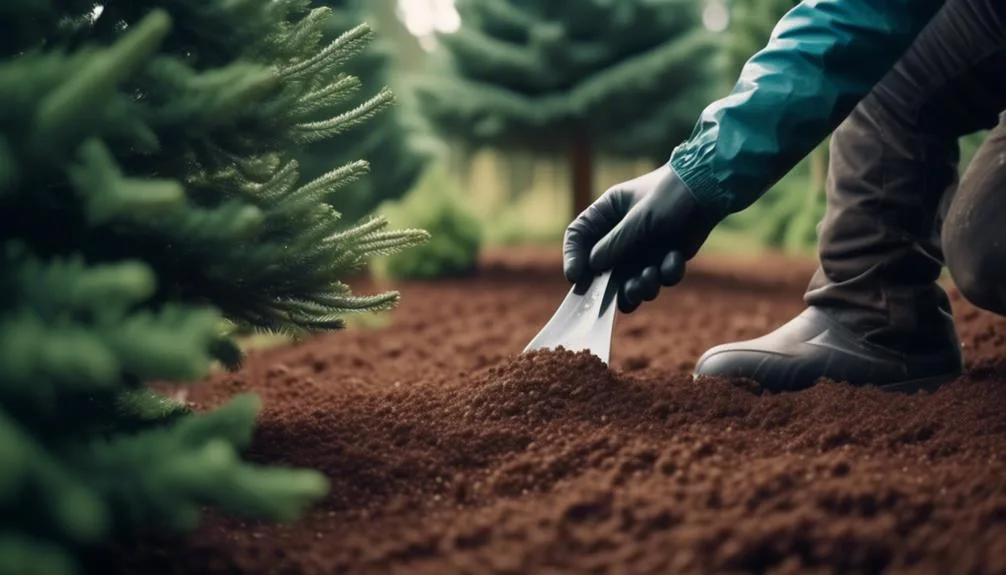Spruce trees are known for their beauty and strength, but keeping them healthy requires understanding their fertilization needs.
Factors like soil testing and selecting the right nutrients play a crucial role.
This discussion aims to provide a clear understanding of how to nourish spruce trees for maximum health and vitality.
Importance of Soil Testing
Before you begin fertilizing your spruce trees, it's essential to understand the importance of soil testing to ensure maximum health and growth.
Soil fertility is crucial for the overall well-being of your spruce trees. Conducting a soil test helps to assess the nutrient deficiencies present in the soil. By identifying any deficiencies, you can tailor your fertilization approach to specifically address the needs of your trees. This targeted approach ensures that your spruce trees receive the necessary nutrients, promoting their growth and vitality.
Without proper soil testing, you may inadvertently apply fertilizers that are unnecessary or even harmful to the existing soil conditions. Therefore, soil testing is a vital step in creating an optimal environment for your spruce trees to thrive.
Understanding Spruce Tree Nutrient Needs
Assessing the specific nutrient requirements of your spruce trees is essential for promoting their optimal growth and health. Understanding the nutrient uptake of spruce trees is crucial for ensuring they receive the necessary elements for robust root development and overall vitality.
Spruce trees typically require a balanced blend of nitrogen, phosphorus, and potassium, along with trace minerals such as iron and magnesium. These nutrients play vital roles in supporting the tree's metabolic processes, root development, and overall resilience to environmental stressors.
Nutrient deficiencies can lead to stunted growth, yellowing needles, and increased susceptibility to pests and diseases. By comprehending the unique nutrient needs of spruce trees, you can tailor your fertilization approach to provide the essential elements that support healthy root systems and robust, vibrant foliage.
Choosing the Right Fertilizer
To ensure your spruce trees receive the necessary nutrients for robust growth and vitality, it's crucial to select the right fertilizer that meets their specific needs. When choosing a fertilizer for your spruce trees, you have two main options: organic fertilizers and synthetic alternatives. Organic fertilizers are derived from natural sources and provide a slow release of nutrients, promoting long-term soil health. On the other hand, synthetic fertilizers are manufactured to deliver specific concentrations of nutrients, providing a quick but temporary boost to tree growth. Below is a comparison table to help you understand the differences between organic and synthetic fertilizers:
| Aspect | Organic Fertilizers | Synthetic Alternatives |
|---|---|---|
| Nutrient Release | Slow | Fast |
| Soil Health | Improves | May degrade over time |
| Environmental Impact | Minimal | Potential chemical runoff |
Consider your spruce tree's specific requirements and your environmental considerations when choosing the right fertilizer for optimal health and growth.
Proper Fertilization Techniques
Considering the specific nutrient needs of your spruce trees and the surrounding environment, employ proper fertilization techniques to ensure their optimal health and growth.
Utilize the deep root application method by inserting a specialized fertilizer probe into the soil, distributing nutrients directly to the tree's root zone. This technique ensures that the fertilizer reaches the tree's root system where it's most needed.
Additionally, consider using a foliar spray technique, where a nutrient-rich solution is applied directly to the tree's foliage. This method can provide a quick nutrient boost, especially for spruce trees with specific nutrient deficiencies.
Both deep root application and foliar spray techniques are effective ways to ensure that your spruce trees receive the essential nutrients required for their overall health and vigorous growth.
Timing and Frequency of Fertilization
When determining the timing and frequency of fertilization for your spruce trees, it's crucial to align these practices with their specific nutrient requirements and the surrounding environmental conditions.
- Optimal Seasons: Consider fertilizing your spruce trees in early spring before new growth begins or in late fall after the tree has gone dormant. These times allow the tree to make the most of the added nutrients.
- Application Rates: It's important to use the right amount of fertilizer. Over-fertilizing can harm the trees, while under-fertilizing may not provide the necessary nutrients.
- Frequency: Typically, spruce trees benefit from annual fertilization. However, it's essential to assess the tree's growth, soil conditions, and nutrient levels to determine if more frequent applications are necessary.
Conclusion
Understanding your spruce tree's nutrient needs through soil testing is crucial for ensuring maximum health. By choosing the right fertilizer and applying it properly, you can provide the necessary nutrients for your spruce trees to thrive and remain healthy for years to come.
Considering timing and frequency are also important factors to optimize the health of your spruce trees. It is essential to apply the fertilizer at the right time, such as early spring or late fall, when the tree is actively growing.
Additionally, you should follow the recommended frequency of application, typically once or twice a year, depending on the specific fertilizer and the needs of your spruce trees.
By following these steps, you can ensure that your spruce trees receive the proper nourishment and have the best chance of staying healthy and vibrant.

My interest in trees started when I first saw the giant sequoias in Yosemite.
I was a teenager then, and I remember thinking, “I need to learn more about this.”
That moment stuck with me.
A few years later, I went on to study forestry at Michigan Tech.
Since graduating, I’ve worked in a mix of hands-on tree care and community education.
I’ve spent over ten years helping people understand how to plant, maintain, and protect the trees in their neighborhoods.
I don’t see trees as just part of the landscape.
They are living things that make a real difference in our daily lives.
